The Muscle Oxygen Monitors Market is estimated to be valued at USD 9.5 million in 2025 and is projected to reach USD 24.2 million by 2035, registering a compound annual growth rate (CAGR) of 9.8% over the forecast period.
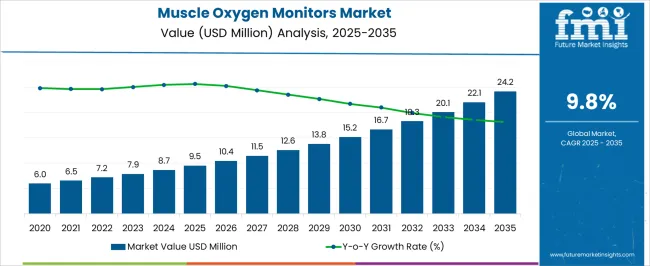
| Metric | Value |
|---|---|
| Muscle Oxygen Monitors Market Estimated Value in (2025 E) | USD 9.5 million |
| Muscle Oxygen Monitors Market Forecast Value in (2035 F) | USD 24.2 million |
| Forecast CAGR (2025 to 2035) | 9.8% |
The Muscle Oxygen Monitors market is being driven by growing interest in health optimization, athletic performance tracking, and recovery management across professional sports and fitness communities. The current market environment is characterized by increasing awareness regarding muscle fatigue, endurance levels, and real-time physiological monitoring, which has encouraged adoption of wearable and portable monitoring systems. Technological advancements in non-invasive sensors, alongside edge computing and data analytics capabilities, are providing users with actionable insights without requiring medical intervention.
The demand has been further supported by rising investments in wellness and preventive healthcare, especially among endurance athletes and rehabilitation patients. The market is expected to expand as training methodologies increasingly incorporate data-driven approaches and as wearable technology becomes more integrated into everyday fitness routines.
Enhanced connectivity with mobile applications and integration with cloud-based analytics platforms have paved the way for new usage models The emphasis on personalized training plans, recovery monitoring, and performance optimization is anticipated to continue contributing to the growth of the market, with technology innovations opening further opportunities in both professional and consumer segments.
The muscle oxygen monitors market is segmented by application type, technology, and geographic regions. By application type, muscle oxygen monitors market is divided into Muscle Oxygen Profile, Heart Rate Profile, and Bicycle Speed. In terms of technology, muscle oxygen monitors market is classified into Peripedal Software, Perfpro Software, and Trainingmate Software.
Regionally, the muscle oxygen monitors industry is classified into North America, Latin America, Western Europe, Eastern Europe, Balkan & Baltic Countries, Russia & Belarus, Central Asia, East Asia, South Asia & Pacific, and the Middle East & Africa.
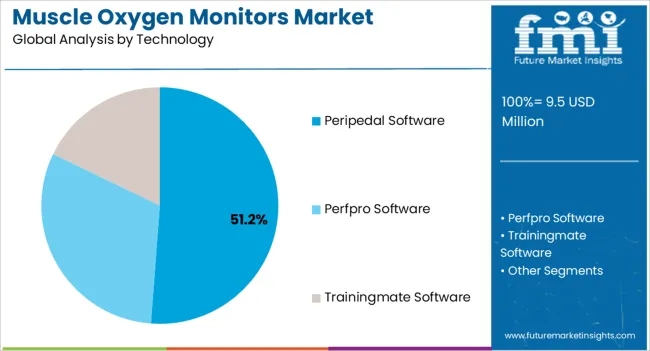
The Muscle Oxygen Profile application type is projected to account for 46.80% of the Muscle Oxygen Monitors market revenue in 2025, making it the leading application segment. This prominence is being attributed to the increasing reliance on real-time muscle oxygen tracking during high-intensity workouts and endurance training. The demand has been encouraged by the growing need among athletes and fitness enthusiasts for data-driven feedback on muscle performance, fatigue levels, and recovery times.
The segment has also benefited from the wider availability of portable and wearable devices that can continuously monitor oxygen saturation without disrupting workout routines. As the focus on sports science and injury prevention continues to expand, the Muscle Oxygen Profile segment has gained prominence, providing users with deeper insights into muscular efficiency and performance under stress.
Furthermore, its use in rehabilitation settings has supported market expansion by enabling practitioners to monitor patient progress during recovery The segment’s contribution is expected to be sustained by ongoing advancements in sensor technologies and user-friendly interfaces that encourage greater adoption.
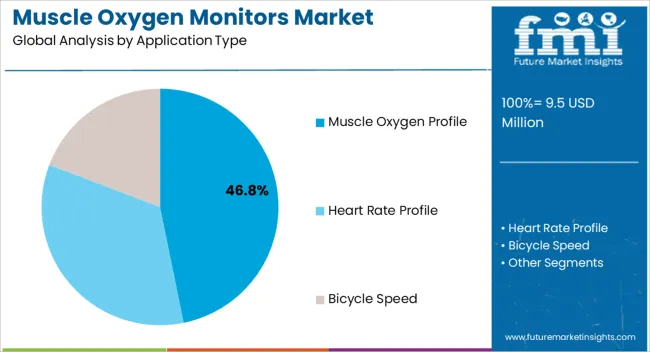
The Peripedal Software technology segment is estimated to hold 51.20% of the Muscle Oxygen Monitors market revenue in 2025, positioning it as the largest technology segment. This leading position is being driven by the growing demand for integrated software platforms that enable seamless data collection, analysis, and personalized feedback. The rise in fitness applications and cloud-based ecosystems has made Peripedal Software solutions more accessible and scalable across different user groups.
These software platforms are being leveraged not only by athletes and trainers but also by healthcare professionals for rehabilitation and muscle performance tracking. The ability to process complex data and present actionable insights in real time has improved user engagement and retention. Software solutions that enable visualization of trends, recovery recommendations, and adaptive training plans are being increasingly preferred over standalone hardware systems.
The segment’s growth has been further supported by the surge in mobile connectivity, allowing users to sync data across devices and access performance reports remotely As personalized health monitoring becomes central to both sports and wellness industries, the Peripedal Software segment is expected to maintain its lead by offering advanced analytics and user-friendly interfaces.
Moxy Muscle Oxygen Monitors measures and monitors the oxygen saturation levels in muscle tissue of athletes. Muscle Oxygen Monitors are based on a technology which is called as Near-Infrared Spectroscopy. It is a kind of spectroscopy method which uses infrared region of the spectrum.
The “Near Infrared” uses light that is at or just beyond the red end of the visible spectrum. Muscle oxygen monitors uses light from about 680 nm to about 800 nm. Near infrared light is used in the process of muscle oxygen monitoring because it can travel a very long distance through skin, muscle and fats. It does not get completely absorbed through skin and hence, travels through a long distance.
The light is scattered through the tissues rather than travelling in a straight line and helps in making quantifiable measurements. The other factor why infrared region is used is that it gets absorbed by haemoglobin and myoglobin molecules which have oxygen bound to them.
Myoglobin is a molecule in muscle cells which is capable of binding and releasing oxygen and acting as a store of oxygen in the muscle.
Haemoglobin is the molecule in red blood cells which is responsible for the transportation of oxygen in the blood. Haemoglobin binds oxygen while passing through lungs and then releases the oxygen when it passes through the capillaries of the tissue that needs it.
Oxygen saturation in the muscles refers to the percentages of haemoglobin and myoglobin which carries oxygen in the muscles. It is derived by taking the amount of oxygen carried by haemoglobin and myoglobin which is then divided by the total amount of haemoglobin and myoglobin. The results obtained is then multiplied by hundred to get it as a percentage.
The muscle oxygen monitors can measure the oxygen saturation percentage which can vary from zero percent to hundred percent. Muscle oxygen monitors performs a secondary measurement of total amount of haemoglobin.
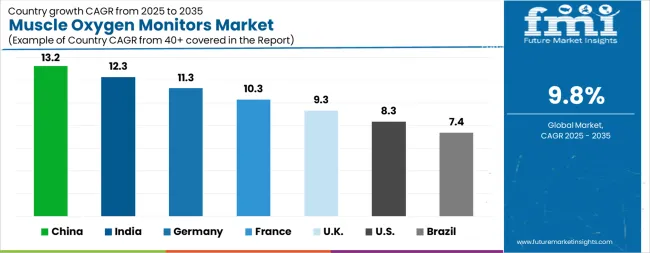
| Country | CAGR |
|---|---|
| China | 13.2% |
| India | 12.3% |
| Germany | 11.3% |
| France | 10.3% |
| UK | 9.3% |
| USA | 8.3% |
| Brazil | 7.4% |
The Muscle Oxygen Monitors Market is expected to register a CAGR of 9.8% during the forecast period, exhibiting varied country level momentum. China leads with the highest CAGR of 13.2%, followed by India at 12.3%. Developed markets such as Germany, France, and the UK continue to expand steadily, while the USA is likely to grow at consistent rates.
Brazil posts the lowest CAGR at 7.4%, yet still underscores a broadly positive trajectory for the global Muscle Oxygen Monitors Market. In 2024, Germany held a dominant revenue in the Western Europe market and is expected to grow with a CAGR of 11.3%.
The USA Muscle Oxygen Monitors Market is estimated to be valued at USD 3.3 million in 2025 and is anticipated to reach a valuation of USD 7.3 million by 2035. Sales are projected to rise at a CAGR of 8.3% over the forecast period between 2025 and 2035. While Japan and South Korea markets are estimated to be valued at USD 486.6 thousand and USD 302.2 thousand respectively in 2025.
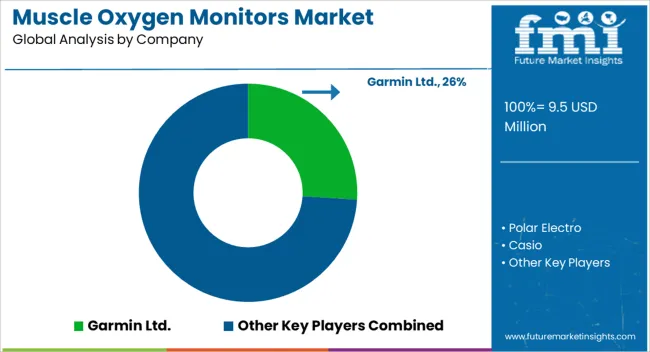
| Item | Value |
|---|---|
| Quantitative Units | USD 9.5 Million |
| Application Type | Muscle Oxygen Profile, Heart Rate Profile, and Bicycle Speed |
| Technology | Peripedal Software, Perfpro Software, and Trainingmate Software |
| Regions Covered | North America, Europe, Asia-Pacific, Latin America, Middle East & Africa |
| Country Covered | United States, Canada, Germany, France, United Kingdom, China, Japan, India, Brazil, South Africa |
| Key Companies Profiled | Garmin Ltd., Polar Electro, Casio, Fitbit, FitBiomics, BSX Athletics, Wahoo Fitness, Respiration Technology Inc., Icon Health & Fitness Inc., Acumen Research and Consulting, Firstbeat Technologies, and Xiaomi |
The global muscle oxygen monitors market is estimated to be valued at USD 9.5 million in 2025.
The market size for the muscle oxygen monitors market is projected to reach USD 24.2 million by 2035.
The muscle oxygen monitors market is expected to grow at a 9.8% CAGR between 2025 and 2035.
The key product types in muscle oxygen monitors market are muscle oxygen profile, heart rate profile and bicycle speed.
In terms of technology, peripedal software segment to command 51.2% share in the muscle oxygen monitors market in 2025.






Our Research Products

The "Full Research Suite" delivers actionable market intel, deep dives on markets or technologies, so clients act faster, cut risk, and unlock growth.

The Leaderboard benchmarks and ranks top vendors, classifying them as Established Leaders, Leading Challengers, or Disruptors & Challengers.

Locates where complements amplify value and substitutes erode it, forecasting net impact by horizon

We deliver granular, decision-grade intel: market sizing, 5-year forecasts, pricing, adoption, usage, revenue, and operational KPIs—plus competitor tracking, regulation, and value chains—across 60 countries broadly.

Spot the shifts before they hit your P&L. We track inflection points, adoption curves, pricing moves, and ecosystem plays to show where demand is heading, why it is changing, and what to do next across high-growth markets and disruptive tech

Real-time reads of user behavior. We track shifting priorities, perceptions of today’s and next-gen services, and provider experience, then pace how fast tech moves from trial to adoption, blending buyer, consumer, and channel inputs with social signals (#WhySwitch, #UX).

Partner with our analyst team to build a custom report designed around your business priorities. From analysing market trends to assessing competitors or crafting bespoke datasets, we tailor insights to your needs.
Supplier Intelligence
Discovery & Profiling
Capacity & Footprint
Performance & Risk
Compliance & Governance
Commercial Readiness
Who Supplies Whom
Scorecards & Shortlists
Playbooks & Docs
Category Intelligence
Definition & Scope
Demand & Use Cases
Cost Drivers
Market Structure
Supply Chain Map
Trade & Policy
Operating Norms
Deliverables
Buyer Intelligence
Account Basics
Spend & Scope
Procurement Model
Vendor Requirements
Terms & Policies
Entry Strategy
Pain Points & Triggers
Outputs
Pricing Analysis
Benchmarks
Trends
Should-Cost
Indexation
Landed Cost
Commercial Terms
Deliverables
Brand Analysis
Positioning & Value Prop
Share & Presence
Customer Evidence
Go-to-Market
Digital & Reputation
Compliance & Trust
KPIs & Gaps
Outputs
Full Research Suite comprises of:
Market outlook & trends analysis
Interviews & case studies
Strategic recommendations
Vendor profiles & capabilities analysis
5-year forecasts
8 regions and 60+ country-level data splits
Market segment data splits
12 months of continuous data updates
DELIVERED AS:
PDF EXCEL ONLINE
Oxygen-Scavenger Sachet Feeders Market Forecast and Outlook 2025 to 2035
Muscle Relaxing Creams Market Size and Share Forecast Outlook 2025 to 2035
Muscle Relaxant Drugs Market Size and Share Forecast Outlook 2025 to 2035
Oxygen-free Copper Market Size and Share Forecast Outlook 2025 to 2035
Oxygen Barrier Films And Coatings For Dry Food Market Size and Share Forecast Outlook 2025 to 2035
Oxygen Scavenger Masterbatch Market Size and Share Forecast Outlook 2025 to 2035
Oxygen Indicator Labels Market Size and Share Forecast Outlook 2025 to 2035
Muscle Stimulator Market Size and Share Forecast Outlook 2025 to 2035
Oxygen Conservation Devices Market Analysis – Size, Share & Forecast 2025 to 2035
Muscle Tension Dysphonia Treatment Market - Trends, Growth & Forecast 2025 to 2035
The Muscle Stimulation Devices Market is segmented by Product, Application and End User from 2025 to 2035
Market Leaders & Share in Oxygen Indicator Labels Manufacturing
Oxygen Therapy Equipment Market Insights – Trends & Forecast 2024 to 2034
Oxygen Barrier Films Market
Oxygen Delivery Units Market
Oxygen Scavenger Market
Oxygen Market
Fish Muscle Protein Market Analysis by Species, Type, Form and Application Through 2035
Trace Oxygen Analyzer Market Analysis - Size, Share & Forecast 2025-2035
Nasal Oxygen Cannula Market

Thank you!
You will receive an email from our Business Development Manager. Please be sure to check your SPAM/JUNK folder too.
Chat With
MaRIA